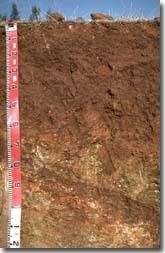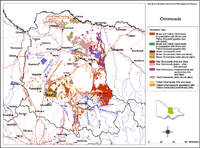Chromosols
Chromosols are soils that display a strong texture contrast between surface (A) horizons and subsoil (B) horizons. The upper part of the subsoil ranges from slightly acid to alkaline (pH >5.5) but is not sodic. Using the Australian Soil Classification, Chromosols can be grouped further (in to Suborders) based on the colour of the upper 20 cm of the subsoil (i.e. Red, Brown, Yellow, Grey and Black). These can be further differentiated based on subsoil characteristics (in to Great Groups) such as the nutrient level capacities and ratios and the presence of carbonate or lime.
Chromosols occur throughout the region and can be found on the alluvial Riverine Plains and the uplands where the dominant occurrences are north, east and west (sporadic occurrences) of Benalla, east of Seymour and the Mansfield area. Surface soil textures and depth vary considerably and have significant implications for management; affecting soil workability, permeability, crop establishment, moisture availability and erodibility. The subsoils of the Brown, Yellow and Grey variants are often mottled. However, this is not the case for some Brown Chromosols on alluvial flats which are friable, where drainage is not restricted. The Red Chromosols are the most permeable of the Chromosols in the region and tend to be in the slightly higher and thus better drained topographic positions, compared to their Brown, Yellow and Grey counterparts. Although in the case of the Mansfield area, subsoil colour is derived from the lithology (i.e. Carboniferous red beds). |  Red Chromosol on Hills near Dookie. |
| Chromosols in the Goulburn Broken Region This broad scale map presents an overview and should only be used as a general indication of the distribution of Chromosols in the Goulburn Broken Region. It shows areas where Chromosols are most likely to occur within the region. Note that other soil types may also occur within these mapped areas (although they are likely to be a more minor component). This map has been developed from work done by DPI's former Centre for Land Protection Research as part of the Goulburn Broken Dryland Regional Development Project. This work utilised existing surveys, remote sensing information and some additional field work to develop an updated 1:100 000 soil/landform coverage across the region. |  Chromosols in the Goulburn Broken Region |
Soils are difficult to map at this broad scale because of their diversity. Even in relatively small areas, a number of soils may occur which relate to differences in topography and landscape position. Variation in some of the major soil profile properties can also occur within these mapped areas. Any agricultural enterprise should be based on a proper on-site assessment of the soil and landscape. A number of soil surveys have been completed in this region at varying scales and intensity. However, in some areas very little soil survey has taken place (refer to the Soil and Land Survey Directory). | |
Red Chromosols
Red Chromosols are found on the Riverine Plains north and east of Benalla, particularly in the Devenish area. Here, the surface soils are often sandy with a variable depth to the subsoil which can be quite permeable. This might be associated with the surrounding granitic areas which have supplied the source material being sand and clay. Similar soils also occur on an outwash fan north of Avenel.
The other major occurrence is in the Mansfield area where the underlying parent material (i.e. Carboniferous sediments) imbues its colour into the soil. However, this area also has some occurrences of Mottled Brown Chromosols as well as black earths and clay soils, depending on landscape position and lithology. The surface soils are silty and some of these soils can be dispersive.
Brown and Yellow Chromosols
Brown and Yellow Chromosols generally have poorer drainage than the Red Chromosols and have either whole-coloured or mottled subsoils (B horizons). Surface horizons are often fine sandy or silty and can be dispersive and result in reduced infiltration. This occurs due to hardsetting of the surface soil on drying and reverting back into a liquid state when there is a small increase in moisture content. Some of these soils may also be sodic in the deeper subsoil and be prone to land degradation (e.g. in the area east of Seymour).
Brown and Yellow Chromosols occur in association with Kandosols in the southern parts of the region and with Kurosols in the granite areas east of Seymour.

